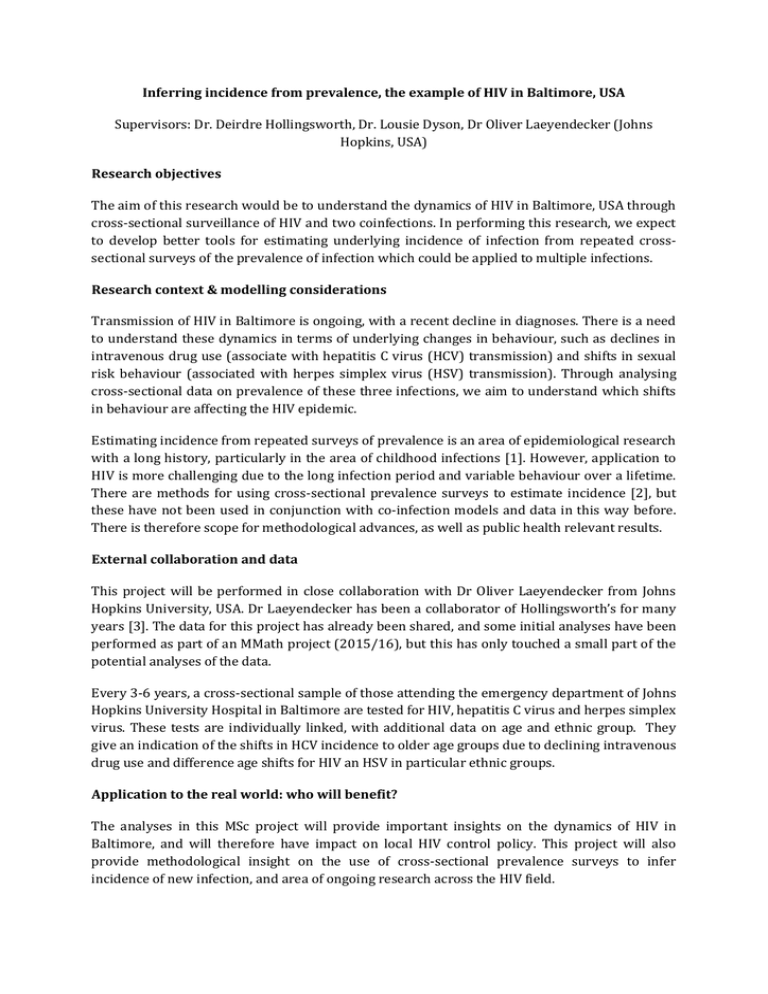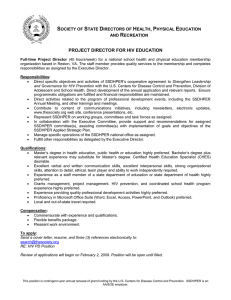Inferring incidence from prevalence, the example of HIV in Baltimore,... Research objectives Hopkins, USA)
advertisement

Inferring incidence from prevalence, the example of HIV in Baltimore, USA Supervisors: Dr. Deirdre Hollingsworth, Dr. Lousie Dyson, Dr Oliver Laeyendecker (Johns Hopkins, USA) Research objectives The aim of this research would be to understand the dynamics of HIV in Baltimore, USA through cross-sectional surveillance of HIV and two coinfections. In performing this research, we expect to develop better tools for estimating underlying incidence of infection from repeated crosssectional surveys of the prevalence of infection which could be applied to multiple infections. Research context & modelling considerations Transmission of HIV in Baltimore is ongoing, with a recent decline in diagnoses. There is a need to understand these dynamics in terms of underlying changes in behaviour, such as declines in intravenous drug use (associate with hepatitis C virus (HCV) transmission) and shifts in sexual risk behaviour (associated with herpes simplex virus (HSV) transmission). Through analysing cross-sectional data on prevalence of these three infections, we aim to understand which shifts in behaviour are affecting the HIV epidemic. Estimating incidence from repeated surveys of prevalence is an area of epidemiological research with a long history, particularly in the area of childhood infections [1]. However, application to HIV is more challenging due to the long infection period and variable behaviour over a lifetime. There are methods for using cross-sectional prevalence surveys to estimate incidence [2], but these have not been used in conjunction with co-infection models and data in this way before. There is therefore scope for methodological advances, as well as public health relevant results. External collaboration and data This project will be performed in close collaboration with Dr Oliver Laeyendecker from Johns Hopkins University, USA. Dr Laeyendecker has been a collaborator of Hollingsworth’s for many years [3]. The data for this project has already been shared, and some initial analyses have been performed as part of an MMath project (2015/16), but this has only touched a small part of the potential analyses of the data. Every 3-6 years, a cross-sectional sample of those attending the emergency department of Johns Hopkins University Hospital in Baltimore are tested for HIV, hepatitis C virus and herpes simplex virus. These tests are individually linked, with additional data on age and ethnic group. They give an indication of the shifts in HCV incidence to older age groups due to declining intravenous drug use and difference age shifts for HIV an HSV in particular ethnic groups. Application to the real world: who will benefit? The analyses in this MSc project will provide important insights on the dynamics of HIV in Baltimore, and will therefore have impact on local HIV control policy. This project will also provide methodological insight on the use of cross-sectional prevalence surveys to infer incidence of new infection, and area of ongoing research across the HIV field. Avenues for PhD research The project can be taken in a number of different directions, depending on the results of the analysis and the interests of the student and collaborators. Potential avenues include Developing tools for inferring incidence from cross-sectional prevalence surveys using different diagnostic markers. Developing models of co-infection, in particular HIV with HCV and HSV, and understanding how their dynamics References [1] Whitaker, H. J., & Farrington, C. P. (2004). Infections with varying contact rates: application to varicella. Biometrics, 60(3), 615-623. [2] Hall, H. Irene, et al. "Estimation of HIV incidence in the United States." Jama 300.5 (2008): 520-529. [3] Hollingsworth, T. D., Laeyendecker, O., Shirreff, G., et al. (2010). HIV-1 transmitting couples have similar viral load set-points in Rakai, Uganda. PLoS Pathog, 6(5), e1000876.

